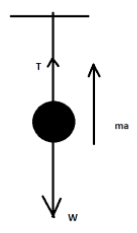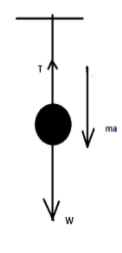
A mass of $1Kg$ is suspended by a thread.it is first lifted up with an acceleration of $4.9m{s^{ - 2}}$, and then lowered with an acceleration of $4.9m{s^{ - 2}}$. What is the ratio of tension in the two cases?
A) $3:1$
B) $1:2$
C) $1:3$
D) $2:1$
Answer
219k+ views
Hint: An external acceleration and retardation is given to the system. While lifting the ball the external acceleration is opposite to the acceleration due to gravity, so, it is the retardation. When the ball is lowered the acceleration is in the direction of the acceleration due to gravity, so, it is the acceleration. Likewise there is an external force acting along with the force of gravity but in the rising case it is in the opposite direction and in the lowering case it is in the same direction.
Formulae used:
$F = ma$
Where $F$ is the force acting on the body, $m$ is the mass of the body and $a$ is the acceleration acting on the body.
$W = mg$
Where $W$ is the force acting on the body, $m$ is the mass of the body and $g$ is the acceleration due to gravity acting on the body.
Complete step by step answer:
In the question, two cases are given. Let us see the free body diagram in each case.
Case 1

In the above diagram, a mass of $1Kg$ is suspended from a thread. Its weight is acting vertically downwards and the tension is acting in vertically upwards direction. So the net force will be,
$ \Rightarrow T - W = ma$
$ \Rightarrow T - mg = ma$
$ \therefore T = ma + mg = m(a + g)$
Substituting the values of $m = 1Kg$, $a = 4.9m{s^{ - 2}}$ and $g = 9.8m{s^{ - 2}}$
$ \therefore T = 1(4.9 + 9.8) = 14.7N$
Case 2

In the above diagram, a mass of $1Kg$ is suspended from a thread. Its weight is acting vertically downwards and the tension is acting in vertically upwards direction. So the net force will be,
$ \Rightarrow W - T = ma$
$ \Rightarrow mg - T = ma$
$ \therefore T = mg - ma = m(g - a)$
Substituting the values of $m = 1Kg$, $a = 4.9m{s^{ - 2}}$ and $g = 9.8m{s^{ - 2}}$
$ \Rightarrow T = 1(9.8 - 4.9) = 4.9N$
Hence the ratio of the tension is,
$ \therefore \dfrac{{{T_1}}}{{{T_2}}} = \dfrac{{14.7}}{{4.9}} = \dfrac{3}{1}$
So the answer will be option (A) i.e. $3:1$.
Note: If the ball was just tied to the string and the entire system was in rest then the tension in the string will be directly equal to the weight of the ball. But since there was an external acceleration and an external retardation, the ball had some net acceleration in both the cases. Hence, the value of tension was different for both the cases.
Formulae used:
$F = ma$
Where $F$ is the force acting on the body, $m$ is the mass of the body and $a$ is the acceleration acting on the body.
$W = mg$
Where $W$ is the force acting on the body, $m$ is the mass of the body and $g$ is the acceleration due to gravity acting on the body.
Complete step by step answer:
In the question, two cases are given. Let us see the free body diagram in each case.
Case 1

In the above diagram, a mass of $1Kg$ is suspended from a thread. Its weight is acting vertically downwards and the tension is acting in vertically upwards direction. So the net force will be,
$ \Rightarrow T - W = ma$
$ \Rightarrow T - mg = ma$
$ \therefore T = ma + mg = m(a + g)$
Substituting the values of $m = 1Kg$, $a = 4.9m{s^{ - 2}}$ and $g = 9.8m{s^{ - 2}}$
$ \therefore T = 1(4.9 + 9.8) = 14.7N$
Case 2

In the above diagram, a mass of $1Kg$ is suspended from a thread. Its weight is acting vertically downwards and the tension is acting in vertically upwards direction. So the net force will be,
$ \Rightarrow W - T = ma$
$ \Rightarrow mg - T = ma$
$ \therefore T = mg - ma = m(g - a)$
Substituting the values of $m = 1Kg$, $a = 4.9m{s^{ - 2}}$ and $g = 9.8m{s^{ - 2}}$
$ \Rightarrow T = 1(9.8 - 4.9) = 4.9N$
Hence the ratio of the tension is,
$ \therefore \dfrac{{{T_1}}}{{{T_2}}} = \dfrac{{14.7}}{{4.9}} = \dfrac{3}{1}$
So the answer will be option (A) i.e. $3:1$.
Note: If the ball was just tied to the string and the entire system was in rest then the tension in the string will be directly equal to the weight of the ball. But since there was an external acceleration and an external retardation, the ball had some net acceleration in both the cases. Hence, the value of tension was different for both the cases.
Recently Updated Pages
Chemical Properties of Hydrogen - Important Concepts for JEE Exam Preparation

JEE General Topics in Chemistry Important Concepts and Tips

JEE Atomic Structure and Chemical Bonding important Concepts and Tips

JEE Amino Acids and Peptides Important Concepts and Tips for Exam Preparation

JEE Extractive Metallurgy Important Concepts and Tips for Exam Preparation

Algebra Made Easy: Step-by-Step Guide for Students

Trending doubts
JEE Main 2026: Application Form Open, Exam Dates, Syllabus, Eligibility & Question Papers

Derivation of Equation of Trajectory Explained for Students

Hybridisation in Chemistry – Concept, Types & Applications

Understanding the Angle of Deviation in a Prism

Understanding Collisions: Types and Examples for Students

Understanding Atomic Structure for Beginners

Other Pages
JEE Advanced Marks vs Ranks 2025: Understanding Category-wise Qualifying Marks and Previous Year Cut-offs

Units And Measurements Class 11 Physics Chapter 1 CBSE Notes - 2025-26

NCERT Solutions For Class 11 Physics Chapter 8 Mechanical Properties Of Solids

Motion in a Straight Line Class 11 Physics Chapter 2 CBSE Notes - 2025-26

NCERT Solutions for Class 11 Physics Chapter 7 Gravitation 2025-26

How to Convert a Galvanometer into an Ammeter or Voltmeter




